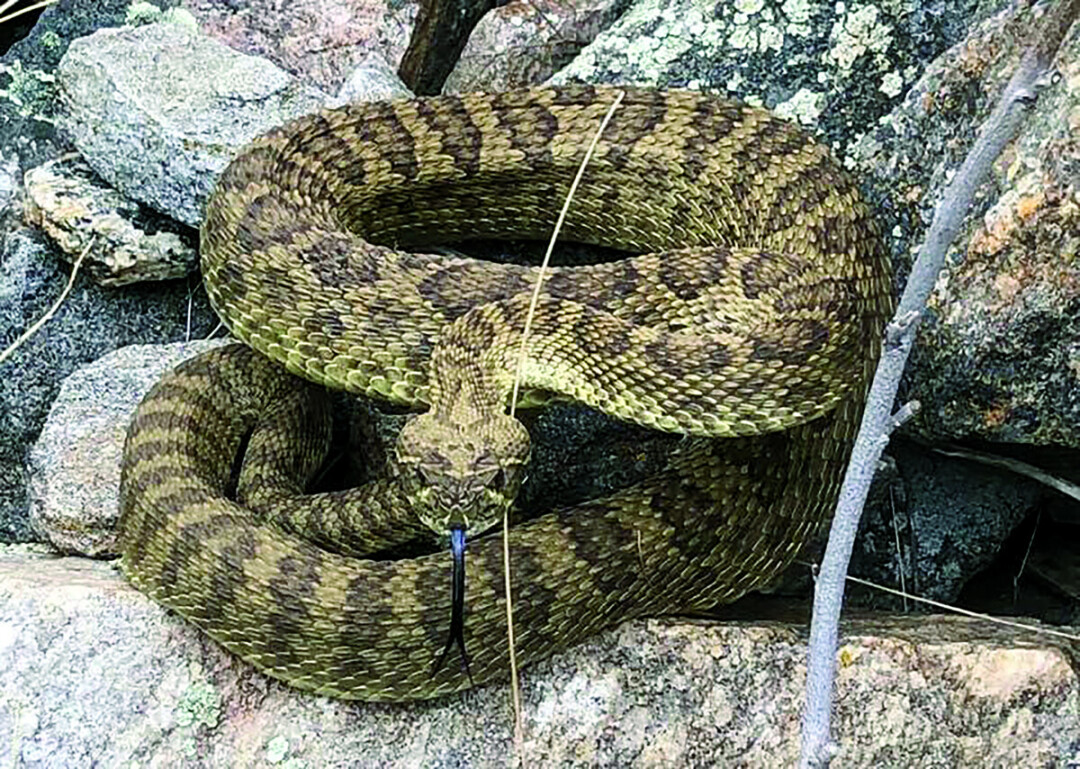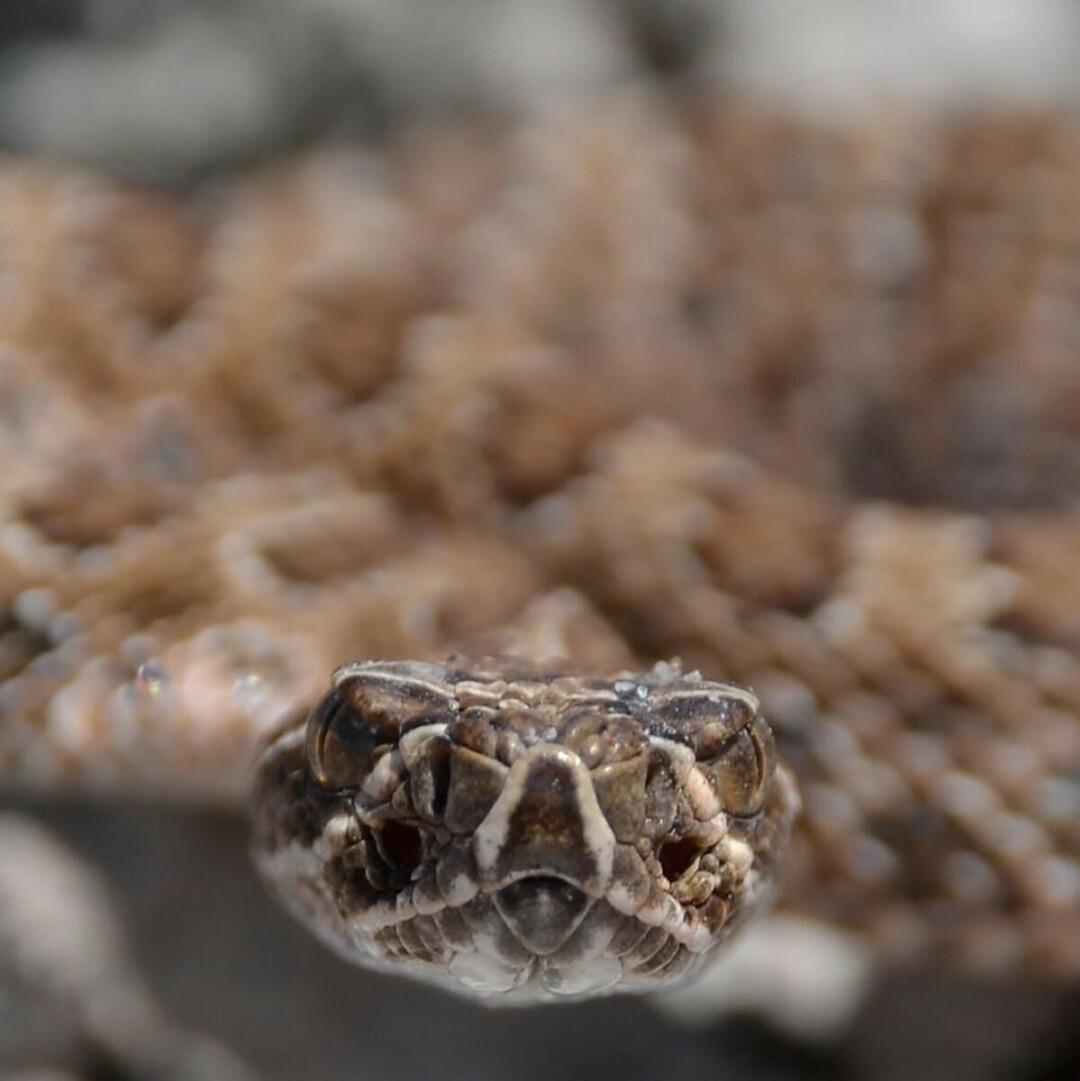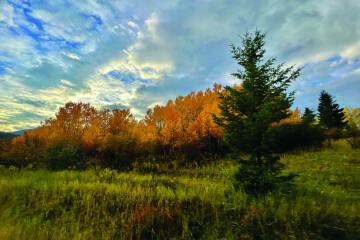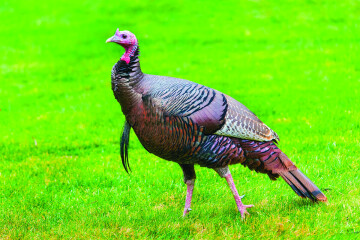Don't Tread On Me
Lewis and Clark's Encounters with Montana's Pit Viper, The Prairie Rattlesnake

Prairie Rattlesnake, Beartrap Canyon, MT. Photo courtesy of Adrianna Frankland
As the thirty-three members of the Lewis and Clark expedition crossed the 104th meridian into present-day Montana with their flotilla of six canoes and two pirogues, the buckskin colored Missouri made its boast: “If you’ve got the gumption to float your boats upstream, then come on up! I’ve got a wealth of unexplored country offering a full plateful of excitement seasoned with a good pinch of danger, immense herds of buffalo, elk, antelope and other critters you’ve never set your eyes on before—wild, untamed country that will stretch the eye and fill the memory banks with places, sights and sounds you never dreamed of.” In those forthcoming weeks of travel when that rare moment of rest from daily activities fell on the expedition, imaginations and expectations ran wild and were at high pitch as to what might be waiting for them around the next river bend. That “good pinch of danger” included numerous (18) close contacts with the prairie rattlesnake, hearing the rapid tail-shaking, spine-chilling buzz of the segmented rattles.
Most references to reptiles, including snakes, reported in the explorers’ diaries are of an incidental nature in comparison to the main priorities of the expedition outlined by President Jefferson. Comments in their diaries about reptiles observed can be rated as “second billing” information in comparison to documented, more enlightening and meaningful information concerning the natural history of the new Northwest acquisition.
SNAKE FOLKLORE
During the timeframe of the Lewis and Clark expedition, little was known about the life history of rattlesnakes and snakebite. Historically, the treatment of snakebite has been surrounded by witchery and mysticism. Superstitions became accepted as facts, imaginary stories passed on as factual truths, and snakes were were at the root of many folklore tales. The science of herpetology would remain dormant for many years before its entry into the scientific natural history disciplines. As a result, a lot of myths circulated about snakes, and most of it was highly imaginative. Expedition member Drouillard’s tale of a gobbler snake serves as a prime example of one’s imagination running at a high pitch. On June 14, 1804, Captain Clark relates Drouillard’s tale in his journal entry: “Drewyer (Drouillard) tells of a remarkable snake inhabiting a small lake, which gobbles like a turkey and may be herd (sic) several miles. This snake is of (immense) size.” Lewis, who bore the discipline of Jeffersonian scientific training, surely must have found Drouillard’s tale amusing but without any scientific fact. Lewis was a part of the fresh intellectual climate spreading across the growing nation. This transition to an open-minded, scientific approach began to seriously question the truth of animal myths, and sought to verify how animals behaved in their natural habitats.
SACAJAWEA’S BIRTH DELIVERY
During the expedition’s 1804-05 winter stay at Fort Mandan Lewis learned of a potential use of pulverized rattlesnake rattles for hastening the birthing process. Lewis’ journal account of the birth of Sacajawea’s child, Jean Baptiste, follows: “About five o’clock this evening, one of the wives of Charbonneau (Sacajawea) was delivered of a fine boy. It is worthy of remark that this was the first child which this woman had borne and, as is common in such cases, her labour was tedious and the pain violent: “Mr. Jessome informed me that he had frequently administered a small portion of the rattle of the rattle-snake, which he assured me had never failed to produce the desired effect, that of hastening the birth of the child. Having the rattle of a snake by me, I gave it to him and he administered two wings of it to the woman, broken in small pieces with the fingers and added to a small quantity of water. Whether this medicine was truly the cause or not, I shall not understand to determine, but I was informed that she had not taken it more than ten minutes before she brought forth. Perhaps this remedy may be worthy of future experiments but I must confess that I want faith as to its efficacy.”
In retrospect, it’s most likely that Lewis did not walk away after the delivery fortified with impious visions as if he had just tasted an apple from the Tree of Knowledge. There are no historical or current medical documentations of rattlesnake rattles being used to hasten birthing in any of the contemporary medical records of American medicine. This makes it most likely that it was entirely a Native American medicinal custom and not used elsewhere.
Juvenile Prairie Rattlesnake, Cascade County, Photo courtesy of Adrianna Frankland
CLARK’S ENCOUNTER WITH A RATTLER
After leaving Fort Mandan on April 7, 1805, the expedition did not encounter any rattlesnakes until they reached the vicinity of present-day Timber Creek in Phillips County, or possibly Seven Blackfoot Creek in Garfield County in northeastern Montana. Lewis reported the following in his journal: “Captain Clark narrowly escaped being bitten by a rattlesnake in the course of his walk; the party killed one this evening at our encampment, which he informed was similar to that he had seen. This snake is smaller than those common to the middle Atlantic States, being about two-feet, six inches long; it is of a yellowish brown colour on the back and sides, variegated with one row of oval spots of a dark brown color lying transversely over the back from the neck to the tail, and two other rows of circular spots of the same colour which garnis the sides along the edge of the scuta. Its belly contains 176 scuta (ventral scales), and [there are] 17 on the tail.”
Lewis’s description of the prairie rattler was surprisingly abbreviated in comparison with his other expedition biological documentations. Conspicuous features that Lewis fails to mention are the triangular head that’s typical of the rattlesnake clan, and the snake’s dark blotches with various shades of brown to black, which are broad anteriorly, but eventually narrow and join with the lateral markings to form crossbands near the tail. Lewis also fails to mention the light stripe extending from behind the eye to the corner of the mouth, and the distinctive loreal pits – a temperature sensitive structure on each side of the face between the eye and nostril.
PIT VIPERS
Rattlesnakes are part of the family of snakes known by herpetologists as pit vipers. Unknown to Lewis and others at this early timeframe, these heat sensitive pits allow rattlers to detect temperature differences between their surroundings and animals up to several yards away. The sensitive pits provide for a “heat picture,” allowing them to detect the size of their prey. To his credit, Lewis provides the first taxonomic description of the prairie rattlesnake, a species then new to science. Despite his early documentation, Constantine Rafinesque would be the first scientist to technically classify and take credit for naming the prairie rattlesnake, Croatalus viridis, in 1818. In later years, taxonomists would apply a name change, Croatalus viridis viridis, designating it as a subspecies.
A SAMPLING OF RATTLER ENCOUNTERS IN MONTANA
As the expedition approached the Great Falls of the Missouri, numerous discomforts and travel difficulties continued to plague the travelers. Among the lurking dangers were encounters with rattlesnakes. A total of 28 rattlesnake encounters are documented in the explorers’ journals, with 18 of them occurring in Montana. Clark graphically describes the hardships in his journal entry of June 15, 1805: “Excessively rapid and difficult to ascend great numbers of dangerous places, and the fatigue which we have to encounter is incredible; the men [are] in the water from morning until night hauling the cord and boats, walking on sharp rocks and round, slippery stones, which alternately cut their feet and throw them down. Notwithstanding all this dificuelty (sic), they go with great cheerfulness. Added to those difficulties, the rattlesnakes [are] innumerable and it requires great caution to prevent being bitten.”
Lewis had his share of adventures while reconnoitering the Great Falls area on June 14 and 15th, 1805. A charging grizzly chased him with an unloaded gun into the Missouri River. A short time later, he was surprised to see a brownish-yellow feline-like animal he could not identify ready to pounce on him. Another bizarre encounter quickly followed: “I had not proceeded more than three hundred yards from the burrow of this tyger cat, before three bull buffaloe, which were feeding with a large herd about half a mile from me on my left, separated from the herd and ran full speed towards me…” The next morning, upon waking, Lewis shot a large rattlesnake, coiled up about 10 feet away in the leaning trunk of the tree he had been sleeping under. Blessed with his inherent competence as a dedicated, systematic naturalist, Lewis took the time after killing the snake to count 176 keeled scales on the abdomen, and 17 rattles.
On July 11, 1805, a few miles east of the present town of Ulm in Cascade County, Private Whitehouse mentions in his diary that while waiting for the wind to abate, he “trod on a very large rattlesnake who bit my legging.” Despite the expedition’s numerous contacts with rattlers at this point in the journey, there is only one report in the journals of a prairie rattler actually striking a member of the party while traveling through Montana. While traveling through Kansas in 1804 on the outward trek, Clark mentions in his diary that “a snake bit Joe Fields on the side of the foot, which swelled much.” Lewis applied a poultice of “Barks” (Peruvian Bark) to the swollen area, which would have been ineffective against rattlesnake venom.
Numerous prairie rattlesnake observations and close calls occurred in Beaverhead County, especially at the Rattlesnake Cliffs, which are located 10 miles southwest of the present town of Dillon near Barrets Siding. On August 10,, 1805, Lewis’ diary entry reads: “From the number of rattlesnakes about the clifts at which we halted, we called them the Rattlesnake Clifts. This serpent is the same as before described, with oval spots of yellowish brown.” Today’s visitors can readily imagine this area as a prime habitat for rattlers. The mind conjures up slithering snakes, spine-chilling rattles, lunging strikes, venomous bites, and rattlesnake dens. The geologic makeup of weathered, extrusive volcanic rocks with numerous cavities and fractures provides for an ideal snake habitat.
On August 15,th Sergeant Ordway reported in his journal that Clark was nearly bitten by a rattlesnake that was between his legs while he was fishing on the Beaverhead River by the Rattlesnake Cliffs. Private Whitehouse further commented in his journal that Clark killed several rattlesnakes that afternoon. Clark adds an additional note about “rattle snake mountain” in his journal entry, mentioning that Sacajawea and Charbonneau also narrowed escaped from being bitten while walking together on shore. August 15th was the last date that rattlesnakes were mentioned in the expedition journals for Montana on the outward journey. There is no further mention of rattlesnakes in the journals until March 11, 1806 when Lewis mentions them in his natural history summary comments at Fort Clatsop in Oregon.
On the return trip in 1806, rattlesnakes are observed on April 25th somewhere between John Day and Willow Creeks in Oregon, or in Klickitat County, Washington on the north side of the Columbia River. Unknown to Lewis, he probably observed what is now known as the Northern Pacific Rattlesnake, Crotalus viridis oreganus, a subspecies of the Western Rattlesnake. No further rattlesnake observations were reported in Montana by the travelers until July 10, 1806, when Clark reported: “Saw several large rattlesnakes in passing the Rattle Snake Mountain—they were fierce.”
On August 4, 1806, Lewis tells of killing a five-foot rattlesnake in Valley County, Montana that had 25 “fully formed scuta” on the tail.
LEWIS’ EXCEPTIONAL OBSERVATIONAL COMPETENCE
Meriwether Lewis added a new page to natural history exploration by describing the physiographic areas through which they traveled, including vegetative landscapes, topography, data on weather recordings, and geological features that became substantial foundation stones for future biological expeditions. The concept of gathering research data from observing animals repeatedly in their respective habitats to generate biological hard facts did not become an accepted standard among research biologists until the 20th century.
Lewis’s natural history documentations, including that of reptiles, have long been recognized as classics in the nation’s biological archives. His literary flair as a gifted biological reporter and his unquestionable curiosity projected natural history information to the reader with a sense of preciseness, grandeur and greatness, allowing for a better understanding of the natural setting in the unexplored lands west of the Mississippi River. We gain the distinct impression that his aesthetic sensitivity to natural systems harbors the vibrant stirrings of an ecological awareness. In the early timeframe of early naturalists who probed the secrets of living systems and their environments, we include Meriwether Lewis, who possessed an objective, systematic and philosophical approach to a better understanding of the natural world.
Humans have always regarded snakes, especially rattlesnakes, with a mixture of fallacious interpretation and fear, of awe and repulsion, all of which provide for rumor, guess and fantasy. Today, a new focus of reality has emerged from the dedicated work of herpetologists, who have provided a new and instructive insight on how the rattlesnake clan plays an important role in the natural ecosystem. Raw research data, by itself, is of little use unless it’s used to create a better understanding of the way in which animals live, and of the forces that shape them.


